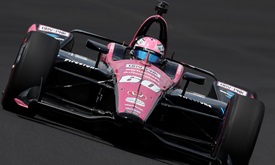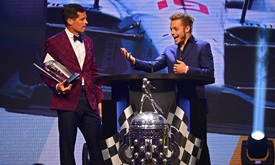From tattoos to tiffs to triumphs, the Indy 500 has it all once more
MAY 28, 2019
Follow Helio Castroneves as he walks from the pits to Gasoline Alley at Indianapolis Motor Speedway. He signs one autograph. Then another. Two autographs become 10, 10 become 20. People lose their composure as he walks past, unable to speak. A man approaches, pulls up his shirt sleeve and shows off an elaborate tattoo featuring the Borg-Warner Trophy and a driver’s autograph.
The man tells Castroneves the driver signed his arm a few days ago, and he had it permanently inked as an addition to his Indy 500 arm art. Then he asks Castroneves, who’s still marveling at the work, to sign his arm not far from the other autograph. With a nervous laugh that says, “If you make this permanent, please don’t blame me in 40 years,” Castroneves carefully signs the man’s arm.
In case you didn’t know it already, the Indianapolis 500 is a big deal. Big enough that people come unglued at the sight of a driver in a bright yellow firesuit. Big enough that people want another person’s signature on a photo or a program. Big enough that some people permanently add another person’s signature on their arms.
And the big deal is getting bigger. The 103rd Indianapolis 500 presented by Gainbridge contained the same elements of recent 500s – compelling drama, exciting racing, a gripping finish – but this one offered a clear look at the uptick in the race and the NTT IndyCar Series. A new TV partner that put everything into its all-day, all-May coverage, an aero kit that has settled into its sophomore season as a viable speedway piece and an event that appeals to hardcore, tatted-up fans as well as casual observers.
It offered the big vs. small drama of Fernando Alonso and Kyle Kaiser in qualifying, which led to several uniquely human stories – the joy of Kaiser and Juncos Racing and the apologies of Alonso and McLaren Sporting Director Gil de Ferran. That moment reiterated a key point about the Indy 500 that had faded in recent decades: this race is, once again, difficult just to get into, let alone win.
It held the mystery of strategy born of the differences between engine manufacturers. Chevrolet had the advantage in horsepower, while Honda had the edge in fuel mileage. Had the race gone green to the end, Scott Dixon would’ve been in excellent shape. As it played out and mileage was removed from the equation, fans were treated to a riveting back-and-forth between Simon Pagenaud and Alexander Rossi (and Chevy and Honda, respectively).
It had anger, too. Rossi was furious – and rightfully so -- on several occasions during his pursuit of the lead. His radio transmissions were proof alone of the importance of the Indy 500. He wanted this race, knew he had a car capable of winning it, was thwarted numerous times by circumstances beyond his control, yet still had a shot at it in the end. His drive was as entertaining as it was frustrating.
There was Takuma Sato’s unlikely rush to the finish. There was the race-altering crash involving Sebastien Bourdais and Graham Rahal. There was the proper decision by INDYCAR Race Control to go red after that crash to clean up the track. There were those five passes for the lead in the final 13 laps.
And then there was Pagenaud, the 2016 series champion who ended a 21-race non-winning streak by winning the INDYCAR Grand Prix, then followed it with the race he wanted most.
“Today was about attacking,” he said Sunday after winning. “We had our strategy meeting this morning, and we decided we were going to attack, we were going to control the day, and we were going to take our fate in our own hands. Destiny is what we decided to control.”
That original autograph tattooed on the fan’s arm? It was Simon Pagenaud, of course, and it’s doubtful the guy will regret it in 40 years. He’ll probably be showing it off and telling the story, again and again, to anyone who’ll listen.
And rightfully so. Because this Indy 500 was indelible.






















